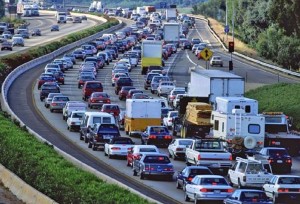Los Angeles has become an unwilling symbol of America’s worsening traffic congestion – its highways and byways often frozen during the steadily expanding period still know as rush hour.
But city planners are betting they can significantly speed things up in the months to come after completing a project that has been in the works for almost three decades.
From the smallest neighborhoods to the biggest downtown intersections, the city has synced all of its stoplights. Covering a vast 469 square miles, LA is the first major city to achieve that milestone and is already showing a reduction in drive times by about 12% in some parts of the city.
“We’re actually seeing traffic flow. That’s such an unusual thing in Los Angeles,” says Michael Rose, a freelance film and documentary producer based near the Los Angeles/Santa Monica border.” It’s such a relief.”
Los Angeles is a city on wheels, and despite ongoing efforts to expand its modest mass transit system, few expect that to move many motorists off the road.
The density of traffic is so severe that freeways – such as the core I-405 route — move at a crawl much of the day. Knowing commuters often abandon those limited-access routes for surface streets, further adding to congestion.
The problem is that a single, poorly timed light along a major street can create a massive ripple effect, creating tie-ups that extend for blocks, even miles, in every direction.
Thus, the goal was to synchronize stop lights so that a car traveling, say, down Wilshire Boulevard, one of the city’s busiest boulevards, could conceivably travel unimpeded for miles if they maintained the posted speed limit.
The challenge has been to coordinate a network of 4,398 street lights, especially when they include complex intersections where three, four, even more different roads merge together.
The project actually dates back to the 1984 Olympics, an event that many city officials feared could create a regional case of gridlock. The first effort to synchronize lights focused on the area around the Los Angeles Memorial Coliseum, site of key Olympic events.
“Because of the success of that system the City Council mandated that we expand it citywide,” Verej Janoyan, senior traffic engineer with the city’s Department of Transportation explains.
Part of the challenge was coming up with the computer capability to properly analyze the city’s vast stoplight network, calculate in posted speed limits and then come up with the proper timing algorithm. That, in itself, wasn’t going to be cheap, but adding in the network to control all those stoplights brought the price tag of the project up to around $350 million. And considering the financial problems facing California and its communities, the project had to be stretched out for nearly 30 years.
The programming isn’t inflexible. The project has also resulted in a network of cameras that can give traffic managers a real-time look at what’s happening on LA streets. They can make rapid changes to reflect shifting daily commute patterns – as well as construction and traffic accidents.
Experts warn that there will still be times when the system is simply overloaded. At the peak of LA’s extended rush hours it can become impossible for motorists to come close to posted speed limits.
But much of the day, there are signs that travel times are being trimmed by as much as 12% in some areas.
It remains to be seen how many of LA’s cash-strapped neighboring communities, especially in the densely populated Orange County, will follow the city’s lead. But studies show that traffic snarls can generate millions of dollars in lost productivity and worsen the region’s endemic smog problems.
“You really see a difference,” says documentary producer Rose. “It’s really amazing. The only question is why they didn’t do this before.”


This is a no brainer. Why this hasn’t been done in all cities decades ago is beyond me.